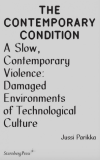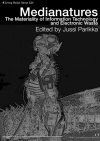Downtime
When things break down, they are much more interesting than the gadgets that function, channel and regulate our lives. Broken things might poetically and with a Heideggerian hum say to reveal their essence. This is the other side of the apocalyptic – to be understood as “apo-kalyptein – an uncovering or disclosing of what had previously been hidden.” (Gere 2008: 13)
It is in this sense that we should talk of “downtime” not as an accidental misfortune, a temporary hiccup and denial of service of intentional nature or just infrastructural/hardware failure. Instead, it is part of how media, tech and things just are (in consumer cultures); that they break down, fail in their intended task, and refuse to switch on. Indeed downtime is the time of permanent breaking down, crisis and one is tempted to start unraveling a wider transversal notion of downtime from the microscale of technological circuits to macroscales of economy. But indeed, if it is a transversal notion it cuts across such traditional divisions of micro and macro and forces a different dimensionality. A molecular level of connections which forces the technological to be tightly articulated as part of political economy; an articulation of politics must take into account the technological conditioning of itself – the political action; the (media) technological sustains and operates the processes of subjectification; the social starts from the circuit.
An installation, Downtime (post-domestic fiction), I saw as part of Amber 2012 exhibition in Istanbul, November 2012, plays with the idea of broken down electronic and other gadgets, from scientific measurement units to an old telephone, television, kitchen utensils (a hand mixer) and an old Spectrum ZX computer. The practice relates to the recent years of circuit bending and hardware hacking, as well as critical design/(re)making, from Garnet Hertz to Benjamin Gaulon and glitchers Jon Satrom to Rosa Menkman, and it might be said to relate to zombie media too–repurposing discarded/dysfunctional gadgets.
For the group, “downtime refers to the period of time during which a system remains unavailable or fails to provide or perform its primary function.” The installation covers a wall with its recircuited works, reminescent of for instance ReFunct Media 2.0. Indeed, this is the interesting bit; it is not so much about the object, but the materiality of its dysfunctionality is articulated as a temporal relation; “the period during which…”. Even downtime unfolds as a duration.
I would argue that there is a twisted permanence, or at least a horizon, a duration, of such a downtime that is as significant as its functionality. “Through the active participation of the viewer, the objects are examined within a new context, in terms of how these are kept active and accessible by its reuse and manipulation”, the group writes. We of course need to investigate the wider sense and rationale of why things should be kept active, and the horizon of that. For me, the interesting bit is as said the temporal dimension, and the new materialist discourse and media technological theory needs to be able to tackle with this too. Whether it is about the temporality of the accident, or the break down, downtime — or then the microtemporality Wolfgang Ernst is after (see also Algorhythmics).
Indeed, the accident and downtime is not only an event that disrupts the running of temporality, but incorporates its own duration that we have to understand too. Downtime is a switch concept for notions of time – functional and dysfunctional, and as such tries to act as an anthropological operator for cultural techniques of temporality.



















Love this photo of broken and breaking technologies and would love to know if there is a catalogue or any other photos from the exhibition in Instanbul that you attended. Great meeting you at CODE 2012! Justine
Hi, was great to meet you! So yes, let me find out if they have more photos, and better quality. These just taken by me.